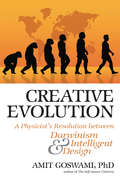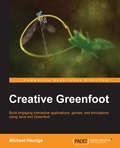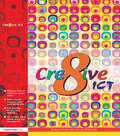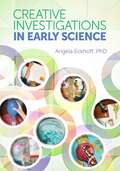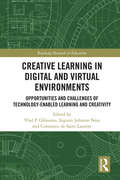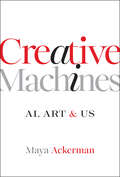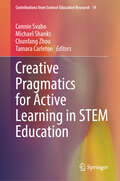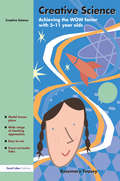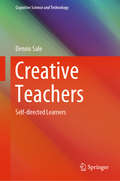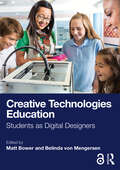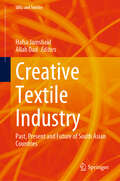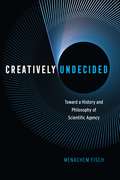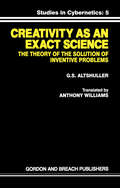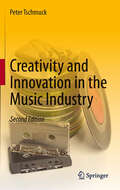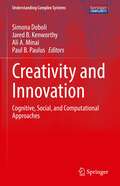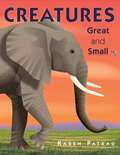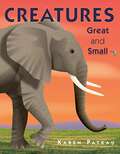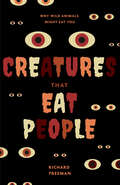- Table View
- List View
Creative Evolution
by Amit GoswamiBy denying evolution altogether, says quantum physicist Amit Goswani, intelligent design believers fly in the face of scientific data. But the idea of intelligent design does contain substance that neo-Darwinists cannot ignore. Goswani posits that consciousness, not matter, is the primary force in the universe. Biology must come to terms with feeling, meaning, and the purposefulness of life, as well as with the idea of a designer. What's more, reconciling the question of life's purposefulness and the existence of the designer with neo-Darwinism also answers many other difficult questions. The result is a paradigm shift for biology and the vision of a coherent whole that Goswami calls "science within consciousness." In this timely, important book, the author offers clear arguments supported by the findings of quantum physics that represent a major step in resolving controversies between science and religion.
Creative Greenfoot
by Michael HaungsThis book is for coding students and Java programmers of all levels interested in building engaging, interactive applications with Greenfoot. Familiarity with the very basics of Greenfoot is assumed.
Creative ICT
by Antony Smith Simon WillcocksFirst Published in 2005. Promoting pupils' creativity in using ICT, this book also encourages learning across core and foundation subjects. The text includes: flexible activities for pupils to work through on their own, in small groups or at home; time-saving screen shots for pupils to refer to as they work through the activities; helpful examples of work so that pupils know what to aim for; additional support sheets that can be used by the pupil or the teacher; departure points for integrated studies; and extension activities that will encourage further creativity. For primary and secondary teachers and ICT- co-ordinators.
Creative Investigations in Early Science
by Angela EckhoffYoung children are born scientists with an innate desire to analyze and investigate the world around them. <p><p> This book helps educators expand and encourage young learners’ inquisitive nature as they explore the physical, life, and earth sciences. Each chapter provides educators practical and approachable ways to intentionally foster young scientists; hands-on, minds-on explorations in the following areas: Matter and physical properties, Physical and chemical changes, Conservation and sustainability, Earth and space systems.
Creative Learning in Digital and Virtual Environments: Opportunities and Challenges of Technology-Enabled Learning and Creativity (Routledge Research in Education)
by Vlad P. Glăveanu; Ingunn Johanne Ness; Constance de Saint LaurentOriginally published as a special issue of the Creativity Research Journal, this volume gives a balanced and reflective account of the challenges and opportunities of technology-enabled creative learning in contemporary societies. Providing a current and updated account of the challenges posed by the Coronavirus to online education, chapters more broadly offer conceptual reflections and empirically informed insights into the impact of technology on individual and collective creativity and learning. These thoughts are explored in relation to school achievement, the development of digital educational resources, online collaboration, and virtual working. Further, the book also considers how the creative use of technology poses risks to learning through the accidental or deliberate dissemination of misinformation, and online manipulation of common societal values in the era of COVID-19. Creative Learning in Digital and Virtual Environments looks at the connection between creativity, learning, and school achievement, and analyses the impact of virtual environments on creative expression. It will appeal to postgraduate students in the fields of creativity and learning, as well as to students and academics involved with broader research in areas such as the role of technology in education, e-Learning and distance education. Vlad P. Glăveanu is Associate Professor and Head of the Department of Psychology and Counselling at Webster University Geneva, Switzerland, as well as Associate Professor II at the University of Bergen, Norway. Ingunn Johanne Ness is a Senior Researcher at the Centre for the Science of Learning & Technology, University of Bergen, Norway. Constance de Saint Laurent is a Postdoctoral Researcher at the University of Bologna, Italy.
Creative Machines: AI, Art & Us
by Maya AckermanA bold and thought-provoking journey into AI's power to transform human creativity In Creative Machines: AI, Art & Us, world-renowned AI researcher and generative AI pioneer, Maya Ackerman, takes you on a thrilling journey into the rise of creative AI, from its earliest pioneers to the cutting-edge tools shaping music, art, and human imagination today. Ackerman cuts through the hype, revealing the true capabilities and limitations of generative AI while championing its potential to amplify human creativity rather than replace it. Drawing on psychology, philosophy, and her own cutting-edge research, she reveals how generative AI exposes both the brilliance and the blind spots of human society—our ingenuity, our biases, our assumptions about intelligence and identity. The book contains: The hidden history and explosive growth of AI-generated creativity Explorations of the true capabilities and limitations of creative AI A visionary framework for using AI as a tool to enhance, rather than hinder, human creativity A bold new perspective on AI ethics and why fixing AI is not enough Perfect for entrepreneurs, tech leaders, developers, ethicists, and creative professionals, Creative Machines offers deep insights, compelling stories, and a visionary perspective on AI's impact on human society. An essential read for anyone doing their best to navigate the rapidly evolving landscape of generative AI.
Creative Pragmatics for Active Learning in STEM Education (Contributions from Science Education Research #14)
by Michael Shanks Tamara Carleton Connie Svabo Chunfang ZhouThis edited volume is an invitation to redesign STEM higher education. It shows the way to active learning in diverse scenarios and provides educators, leaders and policymakers with a visionary approach to active learning and hands-on examples of how education can help students navigate complexity and unpredictability—the challenges of contemporary society. Featuring contributions from a diverse array of scholars and practitioners, this book explores: · Creative learning strategies · Dynamic teacher-student interactions <span style="mso-bidi-font-size
Creative Science: Achieving the WOW Factor with 5-11 Year Olds
by Rosemary FeaseyThrough a refreshing blend of theory and practice this book provides stimulating material to develop creative approaches to science in the classroom. It includes: a range of teaching approaches that relate directly to the topic under discussion examples of pupils' work that portray how theory can be translated into practice quick off-the-shelf example model lesson plans which can be adapted. User-friendly and clearly laid out this book is a core text for primary teachers, NQTs and students who want to inject some creativity into their teaching and put that "WOW" factor back into their science lessons.
Creative Teachers: Self-directed Learners (Cognitive Science and Technology)
by Dennis SaleThis book offers teaching/training professionals an evidence-based pedagogic guide to teaching effectively, efficiently and creatively – also known as Creative Teaching Competence. Firstly it summarizes the extensive research on human psychological functioning relating to learning and how this can be fully utilized in the design and facilitation of quality learning experiences that maximize attainment and engagement opportunities. Secondly, it demonstrates what creativity actually ‘looks like’ in terms of specific teaching practices, modeling the underpinning processes (syntax) of creative learning design. It then establishes Metacognitive Capability as the superordinate twenty-first century competency; in that this unique human attribute can significantly enhance the cognitive and motivational strategies essential for facilitating self-directed learning and wellbeing. The book helps teaching/training professionals to thoughtfully apply evidence-based knowledge and strategies to today’s challenges, such as developing self-directed learners, enhancing intrinsic motivation, utilizing technology for learning and teaching, developing curricula for twenty-first century competencies and optimally framing and developing the heightened teacher expertise required today.
Creative Technologies Education: Students as Digital Designers
by Matt Bower Belinda Von MengersenThis book is a groundbreaking exploration of how to empower students as innovative creators in an increasingly technology-driven world.With rapid advancements in Artificial Intelligence and other technologies reshaping society, this text champions the critical role of creativity in education, explaining how teachers can equip learners with skills for the future workplace and foster their enjoyment of learning through design. Bridging theory and practice, this collaborative work synthesises global research to provide actionable strategies for teachers. From multimedia and game design to Augmented Reality, robotics, 3D fabrication and more, it offers practical insights into how students can use cutting-edge technologies to design, invent, and solve problems creatively. The constructively sequenced and interconnected chapters feature evidence-based principles and real-world vignettes across all levels of schooling.Written by a team of academic experts, this open-access resource is a must-read for educators, researchers, and anyone passionate about unlocking the creative potential of the next generation using technology.
Creative Textile Industry: Past, Present and Future of South Asian Countries (SDGs and Textiles)
by Hafsa Jamshaid Allah DadThis book gives a comprehensive overview of the creative textile industry and its sectors involved in South Asian countries namely Pakistan, India, and Bangladesh. It provides basic knowledge about the textile, fabric manufacturing techniques, processing, and design method used for the development of creative textile products from the three countries in the past till the 1900s to the present 2023 and discusses the future challenges and prospects. It introduces the concept of a multi-species design process as the future need to obtain a sustainable product cycle of creative textile fabrics. The content of this book appeals to academic researchers, industrial practitioners, and policymakers who are interested in the creative textile industry in South Asia, its economics, and sustainability.
Creative astronomy for schoolchildren. Read and paint!
by Olga Kryuchkova Elena KryuchkovaThis book tells about the astronomy and the Universe. About our planet Earth and Earth's satellite Moon, other planets and far constellations. There you can find out interesting and useful information and colorize black and white illustrations depicting mythological characters of planets and constellations. How the Pegasus constellation got this name, what is common between Aphrodite from the sea foam and a planet in the Solar System and more.
Creatively Undecided: Toward a History and Philosophy of Scientific Agency
by Menachem FischThomas Kuhn and Karl Popper are believed by many who study science to be the two key thinkers of the twentieth century. Each addressed the question of how scientific theories change, but they came to different conclusions. By turning our attention to ambiguity and indecision in science, Menachem Fisch, in Creatively Undecided, offers a new way to look at how scientific understandings change. Following Kuhn, Fisch argues that scientific practice depends on the framework in which it is conducted, but he also shows that those frameworks can be understood as the possible outcomes of the rational deliberation that Popper viewed as central to theory change. How can a scientist subject her standards to rational appraisal if that very act requires the use of those standards? The way out, Fisch argues, is by looking at the incentives scientists have to create alternative frameworks in the first place. Fisch argues that while science can only be transformed from within, by people who have standing in the field, criticism from the outside is essential. We may not be able to be sufficiently self-critical on our own, but trusted criticism from outside, even if resisted, can begin to change our perspective—at which point transformative self-criticism becomes a real option.
Creativity As an Exact Science
by G.S. AltshullerThis book discusses the principles of controlling thinking in the solution of inventive problems that are transposed to the organization of creative thinking in any sphere of human activity. It is aimed at the engineer and also comprehensible to people who do not work with technology.
Creativity and Innovation in the Music Industry
by Peter TschmuckWhy did jazz become a dominant popular music genre in the 1920s and rock 'n' roll in the 1950s? Why did heavy metal, punk rock and hiphop find their way from sub-cultures to the established music industry? What are the effects of new communication technologies and the Internet on the creation of music in the early 21st century? These and other questions are answered by Peter Tschmuck through an integrated model of creativity and innovation that is based on an international history of music industry since Thomas A. Edison invented the phonograph in 1877. Thus, the history of the music industry is described in full detail. By discussing the historic process of music production, distribution and reception the author highlights several revolutions in the music industry that were caused by the inference of aesthetic, technological, legal, economic, social and political processes of change. On the basis of an integrated model of creativity and innovation, an explanation is given on how the processes and structures of the present music industry will be altered by the ongoing digital revolution, which totally changed the value-added network of the production, dissemination and use of music. For the second edition, the author has reworked chapter 9 in order to include all the developments which shaped the music industry in the first decade of the 21st century - from Napster to cloud-based music services and even beyond.
Creativity and Innovation: Cognitive, Social, and Computational Approaches (Understanding Complex Systems)
by Ali A. Minai Paul B. Paulus Simona Doboli Jared B. KenworthyThis book focuses on the emergence of creative ideas from cognitive and social dynamics. In particular, it presents data, models, and analytical methods grounded in a network dynamics approach. It has long been hypothesized that innovation arises from a recombination of older ideas and concepts, but this has been studied primarily at an abstract level. In this book, we consider the networks underlying innovation – from the brain networks supporting semantic cognition to human networks such as brainstorming groups or individuals interacting through social networks – and relate the emergence of ideas to the structure and dynamics of these networks. Methods described include experimental studies with human participants, mathematical evaluation of novelty from group brainstorming experiments, neurodynamical modeling of conceptual combination, and multi-agent modeling of collective creativity. The main distinctive features of this book are the breadth of perspectives considered, the integration of experiments with theory, and a focus on the combinatorial emergence of ideas.
Creativity and Time: A Sociological Exploration (Palgrave Studies in Creativity and Culture)
by Juan A. Roche CárcelThis book defends that the pursuit of originality constitutes one of the most important characteristics of creativity, but that originality refers, etymologically, to both origin and originary. Hence, the book is structured into two parts, dedicated, respectively, to the creative categories of origin and the creative categories of originary. Within the former are creation myths, games – the origin of all cultural activity, the dialectic chaos-order, axial civilizations – the germ of our time, and the struggle between generations – a factor of social transformation, and, within the second, creative capitalism, creative work in the context of the global economy of risk and uncertainty, and representative democracy. However, these two concepts are not isolated, but deeply interrelated, in a way that explains how creative originality builds a temporal narrative. It has been dislocated in late modernity and, with it, creativity has been broken.
Creativity and the Brain
by Kenneth M. HeilmanIn Creativity and the Brain, Kenneth Heilman explores the possible brain mechanisms which underlie creativity, by reviewing the existing evidence and putting forward new ideas. On the way, he discusses the relationships between creativity and intelligence, brain anatomy, neuropharmacology, addiction, handedness, sex differences, and mood states such as depression. He also addresses the effects of neurological disorders and aging, as well as the influence of environmental factors such as tolerance and nurturing.The book will be of interest to neuroscientists, psychologists, psychiatrists, neurologists and educators The engaging and succinct style of this book also make it appealing to students, and researchers from a variety of disciplines who have an interest in understanding the brain mechanisms underlying creativity.
Creator and Creators: Co-Creation With Nature - A Synthesis Of Spiritual Philosophy And Science
by Roza Riaikkenen Margarita RiaikkenenCreator and Creators starts from the point of Nothing/Everything and the cosmic Rhythm, and gradually includes and explains the esoteric and exoteric mechanisms that lead to manifestation of life as we know it. Through an analysis of personal experience and the synthesis of spiritual philosophy and modern discoveries in cosmology, quantum physics, and the holographic mechanisms of genetics and neurophysiology Creator and Creators develops a new definition of Matter and new explanations of the nature of Time, Gravitational Waves, and Dark Energy. The book also solves the argument between the creationists and evolutionists by providing a cyclic theory of Creation and Evolution.
Creature Features: Twenty-Five Animals Explain Why They Look the Way They Do
by Steve Jenkins Robin PageDear axolotl: Why do you have feathers growing out of your head? Axolotl: They aren't feathers—they're gills! They let me breathe underwater. Let's face it. Even as babies, we humans pay close attention to faces. Observing another person's features and expressions tells us whether they are happy, angry, excited, or sad. And when we look at an animal, it's hard not to imagine that its face is communicating human feelings. This isn't true, of course. Squinty eyes, an upturned mouth, or another odd expression is probably there because, in some way, it helps that animal survive. Packed with many cool facts and visuals on where certain animals live and what they eat, this book captures twenty-five humorous—and very true—explanations of why animals look the way they do in order to exist in this world.
Creatures Born of Mud and Slime: The Wonder and Complexity of Spontaneous Generation (Singleton Center Books In Premodern Europe Ser.)
by Daryn LehouxA history and analysis of the theory of spontaneous generation and how scientific thought progresses.We accept that, at some point in the history of our universe, living creatures emerged from nonliving matter. Yet from the time of Aristotle until the late nineteenth century, many people believed in spontaneous generation, that living creatures sprang into existence from rotting material. As Daryn Lehoux explains in this fascinating book, spontaneous generation was perhaps the last stand of the ancient scientific worldview.In Creatures Born of Mud and Slime, Lehoux shows that—far from being a superstitious, gullible, or simplistic belief—spontaneous generation was a sophisticated and painstakingly grounded fact that stood up to the best scientific testing. Starting with the ancient Greeks’ careful and detailed investigations into how animals are generated straight through to the early modern period, Lehoux brings to life the intellectual contexts, rivalries, observational evidence, and complex and fascinating theories that were used to understand and explain the phenomena.The book highlights both the weirdness and the wonder that lie at the heart of investigations into nature. Lehoux concludes with a new look at a set of conflicting experiments that demonstrate that even the best scientific evidence can end up muddying what we take to be the truth about the world. Creatures Born of Mud and Slime is a compelling look at how we understand conceptions of scientific change, truth, and progress.“A very well-written and well-researched book that grapples with the foundational questions of the history of Western philosophy.” —Justin E. H. Smith, author of The Philosopher: A History in Six Types“A historical tour de force . . . the author’s brilliant prose [makes] the reader appreciate at one time the strangeness and the persuasive power of outmoded scientific explanations.” —Paolo Savoia, Nuncius 34“Concise and accessible, Lehoux’s clarity and graceful prose make this book . . . a pleasure to delve into.” —James Strick, HOPOS 8
Creatures Born of Mud and Slime: The Wonder and Complexity of Spontaneous Generation (Singleton Center Books in Premodern Europe)
by Daryn LehouxHow did the concept of spontaneous generation survive for so long?We accept that, at some point in the history of our universe, living creatures emerged from nonliving matter. Yet from the time of Aristotle until the late nineteenth century, many people believed in spontaneous generation, that living creatures sprang into existence from rotting material. As Daryn Lehoux explains in this fascinating book, spontaneous generation was perhaps the last stand of the ancient scientific worldview. In Creatures Born of Mud and Slime, Lehoux shows that—far from being a superstitious, gullible, or simplistic belief—spontaneous generation was a sophisticated and painstakingly grounded fact that stood up to the best scientific testing. Starting with the ancient Greeks’ careful and detailed investigations into how animals are generated straight through to the early modern period, Lehoux brings to life the intellectual contexts, rivalries, observational evidence, and complex and fascinating theories that were used to understand and explain the phenomena.The book highlights both the weirdness and the wonder that lie at the heart of investigations into nature. Lehoux concludes with a new look at a set of conflicting experiments that demonstrate that even the best scientific evidence can end up muddying what we take to be the truth about the world. Creatures Born of Mud and Slime is a compelling look at how we understand conceptions of scientific change, truth, and progress.
Creatures Great And Small
by Karen PatkauJoin Toronto author and illustrator Karen Patkau as she explores the world of insects, mammals, sea jellies, reptiles, amphibians, birds, crustaceans, arachnids, and mollusks. From extremely large creatures, such as the blue whale, Chinese giant salamander, and goliath tarantula, to extremely small ones, such as the bumblebee bat, dwarf gecko, and fairy shrimp, embark on this informative, beautifully illustrated voyage of discovery. Even the simple fact-filled text is enchantingly presented in the voices of the animals themselves. A glossary, map endpapers, and handy charts — introducing the concepts of scale and proportion by comparing measurements of animals that are “Big” and “Really Big” to “Small” and “Really Small” — make this book a must-have for parents, schools, and libraries alike.
Creatures Great and Small
by Karen PatkauJoin Toronto author and illustrator Karen Patkau as she explores the world of insects, mammals, sea jellies, reptiles, amphibians, birds, crustaceans, arachnids, and mollusks. From extremely large creatures, such as the blue whale, Chinese giant salamander, and goliath tarantula, to extremely small ones, such as the bumblebee bat, dwarf gecko, and fairy shrimp, embark on this informative, beautifully illustrated voyage of discovery. Even the simple fact-filled text is enchantingly presented in the voices of the animals themselves. A glossary, map endpapers, and handy charts — introducing the concepts of scale and proportion by comparing measurements of animals that are “Big” and “Really Big” to “Small” and “Really Small” — make this book a must-have for parents, schools, and libraries alike.
Creatures That Eat People: Why Wild Animals Might Eat You
by Richard FreemanWild Animals Might Eat You—Learn Which Ones“Informative and very entertaining”—Readers of Richard’s booksCreatures That Eat People is an action-packed deep dive on predators that turn man eater. Learn about past and present cases on human eating animals—big and small—so you can survive being hunted!Avoid getting eaten!Do you find yourself wondering: Do bears eat humans? Do snakes eat people? Could I survive people-eating predators of any kind? Perfect for anyone with a fun or morbid interest in wildlife or survivalism, Creatures That Eat People is full of stories of strange animals that eat humans and the situations that lead to it.Learn which wild animals might eat you—from an expert. Cryptozoologist, former zookeeper, current zoological director, best-selling author, and animal enthusiast Richard Freeman examines all the cool man eaters in the animal kingdom—so you can be prepared on your next adventure.Inside, you’ll find:Tips for visiting different types of areas with apex predators in themBears, sharks, crocodiles, snakes, and other other weird, wild animals that eat peopleReal-life, thrilling stories of animals eating people—and some survive and some don’tIf you liked How To Survive A Freakin’ Bear Attack, Plants That Kill, Surviving the Wild, or In Search of Real Monsters, and if you enjoyed shows like Tiger King or Human Prey, you’ll love Creatures That Eat People.
